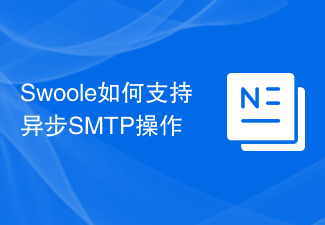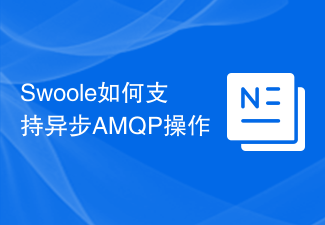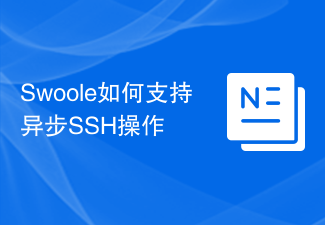 Backend Development
Backend Development PHP Tutorial
PHP Tutorial Asynchronous coroutine development practice: building a high-performance message queue system
Asynchronous coroutine development practice: building a high-performance message queue system
Asynchronous coroutine development practice: building a high-performance message queue system
With the development of the Internet, the message queue system has become an important tool for building high-performance and scalable Key components of distributed systems. In building a message queue system, the application of asynchronous coroutines can effectively improve the performance and scalability of the system. This article will introduce the practical development of asynchronous coroutines, taking building a high-performance message queue system as an example, and provide specific code examples.
- The concept and advantages of asynchronous coroutines
Asynchronous coroutines are an event-driven concurrent programming model that can achieve high concurrency processing in a single thread. Compared with the traditional multi-threading model, asynchronous coroutines have the following advantages:
1.1 Lightweight: Asynchronous coroutines do not need to create additional threads, only a small number of coroutines need to be created. Large-scale concurrency can be achieved. This greatly reduces the consumption of system resources.
1.2 Efficiency: Asynchronous coroutines utilize non-blocking I/O and event-driven mechanisms to achieve efficient task scheduling and processing with extremely low overhead and will not suffer from the overhead of context switching.
1.3 Scalability: Asynchronous coroutines can automatically expand as the system load increases, without the need to manually adjust parameters such as thread pool size.
- Design and implementation of message queue system
When designing a message queue system, the first thing we need to consider is the data structure of the queue and the producer-consumer model of the message. Common message queue systems generally use a first-in-first-out (FIFO) data structure and a publish-subscribe model to implement message delivery between producers and consumers. The following is a sample code of a simple message queue system developed based on asynchronous coroutines:
import asyncio
message_queue = []
subscriptions = {}
async def publish(channel, message):
message_queue.append((channel, message))
await notify_subscribers()
async def notify_subscribers():
while message_queue:
channel, message = message_queue.pop(0)
for subscriber in subscriptions.get(channel, []):
asyncio.ensure_future(subscriber(message))
async def subscribe(channel, callback):
if channel not in subscriptions:
subscriptions[channel] = []
subscriptions[channel].append(callback)
async def consumer(message):
print("Received message:", message)
async def main():
await subscribe("channel1", consumer)
await publish("channel1", "hello world")
if __name__ == "__main__":
asyncio.run(main())In the above code, we use a message_queue list to store published messages, using A dictionary subscriptions to store subscribers and corresponding channels. publish function is used to publish messages, notify_subscribers function is used to notify subscribers, subscribe function is used to subscribe to a channel, consumer function Consumer as an example.
In the main function, we first subscribe to the channel1 channel using the subscribe function and specify the consumer function for subscribers. Then we use the publish function to publish a message to the channel1 channel, and notify_subscribers will automatically send the message to the subscribers.
- Performance Optimization and Expansion
In order to further optimize and expand the performance of the message queue system, we can use asynchronous I/O and coroutine pools in combination to improve message processing capabilities. By using asynchronous I/O, we can make full use of system resources and improve system throughput. Coroutine pools can be used to limit the number of concurrent tasks and avoid excessive context switches.
The following is an optimized sample code for a message queue system based on asynchronous I/O and coroutine pool:
import asyncio
from concurrent.futures import ThreadPoolExecutor
message_queue = []
subscriptions = {}
executor = ThreadPoolExecutor()
async def publish(channel, message):
message_queue.append((channel, message))
await notify_subscribers()
async def notify_subscribers():
while message_queue:
channel, message = message_queue.pop(0)
for subscriber in subscriptions.get(channel, []):
await execute(subscriber(message))
async def execute(callback):
loop = asyncio.get_running_loop()
await loop.run_in_executor(executor, callback)
async def subscribe(channel, callback):
if channel not in subscriptions:
subscriptions[channel] = []
subscriptions[channel].append(callback)
async def consumer(message):
print("Received message:", message)
async def main():
await subscribe("channel1", consumer)
await publish("channel1", "hello world")
if __name__ == "__main__":
asyncio.run(main())In the optimized sample code, we use executorTo create a coroutine pool and put the callback function into the coroutine pool for execution through the execute function. This can avoid excessive context switching, execute callback functions concurrently, and improve message processing capabilities.
Of course, in the actual message queue system, it can be further optimized and expanded, such as introducing message persistence, message confirmation mechanism, horizontal expansion, etc.
- Summary
This article introduces the actual development of asynchronous coroutines, taking building a high-performance message queue system as an example, and provides specific code examples. Asynchronous coroutines can achieve efficient task scheduling and processing with extremely low overhead, and can effectively improve system performance and scalability. By combining technologies such as asynchronous I/O and coroutine pools, we can further optimize and expand the message queue system to adapt to different application scenarios and needs.
The above is the detailed content of Asynchronous coroutine development practice: building a high-performance message queue system. For more information, please follow other related articles on the PHP Chinese website!
 快速应用:PHP 异步 HTTP 下载多个文件的实用开发案例分析Sep 12, 2023 pm 01:15 PM
快速应用:PHP 异步 HTTP 下载多个文件的实用开发案例分析Sep 12, 2023 pm 01:15 PM快速应用:PHP异步HTTP下载多个文件的实用开发案例分析随着互联网的发展,文件下载功能已成为很多网站和应用程序的基本需求之一。而对于需要同时下载多个文件的场景,传统的同步下载方式往往效率低下且耗费时间。为此,使用PHP异步HTTP下载多个文件成为了一种越来越常见的解决方案。本文将通过一个实际的开发案例,详细分析如何使用PHP异步HTTP
 Swoole如何支持异步SMTP操作Jun 25, 2023 pm 12:24 PM
Swoole如何支持异步SMTP操作Jun 25, 2023 pm 12:24 PM随着互联网的不断发展和普及,电子邮件已经成为了人们生活和工作中必不可少的一部分,而SMTP(SimpleMailTransferProtocol,简单邮件传输协议)则是邮件发送的重要协议之一。Swoole作为PHP的一个异步网络通讯框架,可以很好地支持异步SMTP操作,使邮件发送更加高效和稳定。本文将介绍Swoole如何支持异步SMTP操作,包括使用步
 Swoole如何支持异步AMQP操作Jun 25, 2023 am 08:22 AM
Swoole如何支持异步AMQP操作Jun 25, 2023 am 08:22 AM随着互联网业务量的不断增长,对于高并发和高性能的需求越来越高,而Swoole作为PHP的一款网络通信框架,也越来越受到开发者的青睐。其中,Swoole支持异步AMQP是比较常见的应用场景之一。那么我们来看看Swoole如何支持异步AMQP操作。首先,我们需要明确什么是AMQP。AMQP(AdvancedMessageQueuingProtocol)高级
 Vue文档中的异步请求函数的使用方法Jun 20, 2023 pm 05:55 PM
Vue文档中的异步请求函数的使用方法Jun 20, 2023 pm 05:55 PMVue.js是一种流行的前端JavaScript框架,它提供了一种在应用程序中构建用户界面的方式。在Vue.js的文档中,我们可以找到很多有用的信息,特别是关于如何使用异步请求函数。异步请求函数是一种在应用程序中执行异步任务的方式。它们被用于从服务器获取数据、处理输入、验证表单等。一般情况下,异步请求函数需要与Promise、async和await等Java
 如何使用ThinkPHP6进行异步日志记录操作?Jun 12, 2023 am 09:57 AM
如何使用ThinkPHP6进行异步日志记录操作?Jun 12, 2023 am 09:57 AM随着互联网的高速发展,日志记录服务成为了每个大型web应用必不可少的模块。为了方便错误排查、性能监控等各种需求,本文将介绍如何使用ThinkPHP6框架进行异步日志记录操作。1.什么是日志记录在计算机科学领域,日志记录是指将计算机系统中发生的事件和信息记录下来。通常,这些记录都以文件或数据库的形式存储。日志记录有助于了解系统运行状况,及时发现和解决
 Swoole如何支持异步SSH操作Jun 25, 2023 am 11:10 AM
Swoole如何支持异步SSH操作Jun 25, 2023 am 11:10 AMSwoole是一个为高并发而设计的PHP扩展,可以大幅提升PHP的性能。它支持异步IO、协程、多进程等特性,在网络编程、高负载场景中表现出色。本文将介绍Swoole如何支持异步SSH操作。一、SSH介绍SSH(SecureShell)是一种加密的网络协议,用来在网络中进行安全地传输信息。SSH协议具有安全、可靠、跨平台等特点,广泛应用于远程登录、文件传输、
 PHP8.1新增的异步HTTP客户端Jul 08, 2023 pm 07:24 PM
PHP8.1新增的异步HTTP客户端Jul 08, 2023 pm 07:24 PMPHP8.1新增的异步HTTP客户端随着互联网的快速发展,各种Web应用程序的性能也变得越来越重要。为了提供更好的用户体验,开发人员需要使用高效的工具和技术来处理各种网络请求。幸运的是,PHP8.1引入了一个全新的功能,即异步HTTP客户端,它允许我们以非阻塞的方式执行HTTP请求,从而提高应用程序的性能。通过异步HTTP客户端,我们可以在发送请求后继续执行
 如何利用Celery、Redis和Django实现异步任务队列Sep 27, 2023 pm 11:18 PM
如何利用Celery、Redis和Django实现异步任务队列Sep 27, 2023 pm 11:18 PM如何利用Celery、Redis和Django实现异步任务队列引言:在Web开发中,经常需要处理一些耗时较长的任务,如发送邮件、生成报表、处理大量数据等。如果将这些任务直接放在视图函数中处理,会导致请求响应时间过长,用户体验不佳。为了提高系统的性能和响应速度,我们可以使用异步任务队列来处理这些耗时的任务。Celery是一个广泛使用的Python的异步任务队列


Hot AI Tools

Undresser.AI Undress
AI-powered app for creating realistic nude photos

AI Clothes Remover
Online AI tool for removing clothes from photos.

Undress AI Tool
Undress images for free

Clothoff.io
AI clothes remover

AI Hentai Generator
Generate AI Hentai for free.

Hot Article

Hot Tools

Dreamweaver CS6
Visual web development tools

WebStorm Mac version
Useful JavaScript development tools

Zend Studio 13.0.1
Powerful PHP integrated development environment

SAP NetWeaver Server Adapter for Eclipse
Integrate Eclipse with SAP NetWeaver application server.

Safe Exam Browser
Safe Exam Browser is a secure browser environment for taking online exams securely. This software turns any computer into a secure workstation. It controls access to any utility and prevents students from using unauthorized resources.




